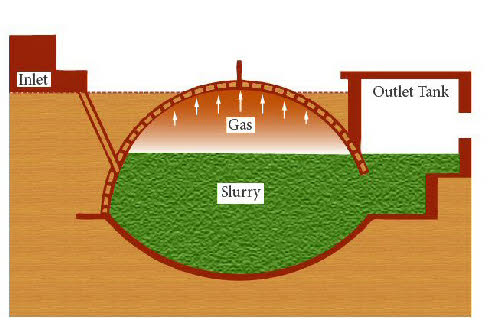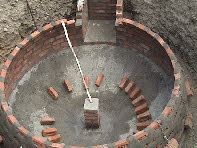



A domestic bio-gas unit is a digesting chamber where manure, from both cows and humans, ferments to provide biogas, through the release of methane. Biogas is seen as a clean fuel, and provides a feasible alternative to cooking gas. In colder climates like the lower regions of the Himalaya the Deenbandhu fixed model is ideal because the digestion chamber is underground providing good insulation against the cold.
We have found that the critical factors for success with Bio-gas are ensuring quality during construction, and training user groups in the correct use and maintenance of their plants. Ignoring these critical issues often leads to the failure of bio-gas plants perpetuating the myth that bio-gas technology is inappropriate in the Himalaya and elsewhere in the country.
We use a design optimised for a longer 55 day cycle so that the mixture gets more time for digestion. Care is also taken to choose sites that get 2-3 hours of sunlight in winter. We have found that while the production of gas does reduce by about 25% during three months in winter, the plants function very well and one cubic metre plant provides 2-3 hours of clean cooking fuel every day. For rural communities this not only provides efficient low-cost fuel but reduces the strains of overgrazing of animals on the land.
We use a design optimised for a longer 55 day cycle so that the mixture gets more time for digestion. Care is also taken to choose sites that get 2-3 hours of sunlight in winter. We have found that while the production of gas does reduce by about 25% during three months in winter, the plants function very well and one cubic metre plant provides 2-3 hours of clean cooking fuel every day. For rural communities this not only provides efficient low-cost fuel but reduces the strains of overgrazing of animals on the land.

The main feature of a Deenbandhu biogas plant is the fixed underground digester chamber, constructed with a layer of bricks and an additional layer of cement mortar forming the roof above. Connected to the underground chamber is an inlet tank (labelled on diagram as “Mixing Tank”), through which manure is fed into the plant. The manure then ferments separating the slurry from the methane gas which rises and collects at the top of the digester tank, and is released through the gas outlet pipe. The slurry passes into the outlet tank where it is ejected from the plant and can be used as fertilizer on the field










